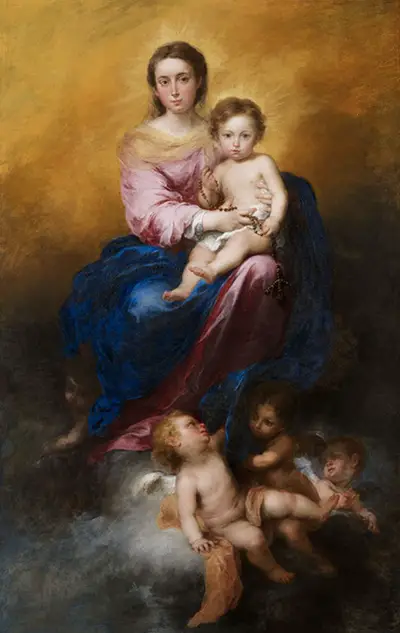The Virgin of the Rosary by Bartolomé Esteban Murillo is part of the permanent collection of the Dulwich Picture Gallery in London, UK.
Introduction
This is one of a number of interpretations on this topic from the famous Spanish artist, with another currently residing in the Prado Museum in Madrid. Murillo himself regularly re-visited religious themes across his career, including two dozen of the Immaculate Conception, for example.
Description
This particular version of The Virgin of the Rosary is memorable for its striking color, with dark blue tones combined with purples and yellows, giving a vibrant finish. It is likely that the materials used for this piece, both in terms of paint and canvas, were of a particularly high standard, suggesting a wealthy donor for this commission.
The Virgin and Christ Child are placed centrally, dominating the upper half of the scene. Most of the lower half is devoted to a series of angels who playfully congregate around the Virgin's feet. The child wears only a small cloth around his midrift, whilst the Virgin sports a multi-colored ensemble, with dark blue dress, pink upper, and darker touches of purple.
A mustard tone stretches across the background and contrasts beautifully against the blue tones of her clothing. Murillo liked to create dreamy atmospheres through his brushwork in this latter part of his career, and this piece would become regarded as an excellent addition to the collection in Dulwich.
The postures and positioning of the two main subjects for this piece is relatively formal as compared to Murillo's other versions. In that sense, there is less of an emotional connection between mother and child, as they both look separately in our direction.
Size and Date
The painting itself is dated to 1675-80, placing it right at the back end of the artist's career. It stands at two metres in height, and around 128 cm in width, making it typically large for this painter. Such large canvases allowed Murillo to incorporate precise detail in his work, with only a small handful of figures included within this particular composition.
Location
At the time of writing, the painting is located in Gallery 1 of the Dulwich Picture Gallery, which is based in South London. The item is believed to have been bequeathed to the gallery as far back as 1811, making it one of the longest serving parts of their collection.
Conclusion
Despite Murillo's frequent repetition of themes across his career, this piece remains an excellent addition to his oeuvre. The use of color is exquisite, and the formal postures offer something different to his work in the Prado, for example. It also helps to illustrate his stylistic transition from around the mid-17th century to the work closer to the end of his career.




